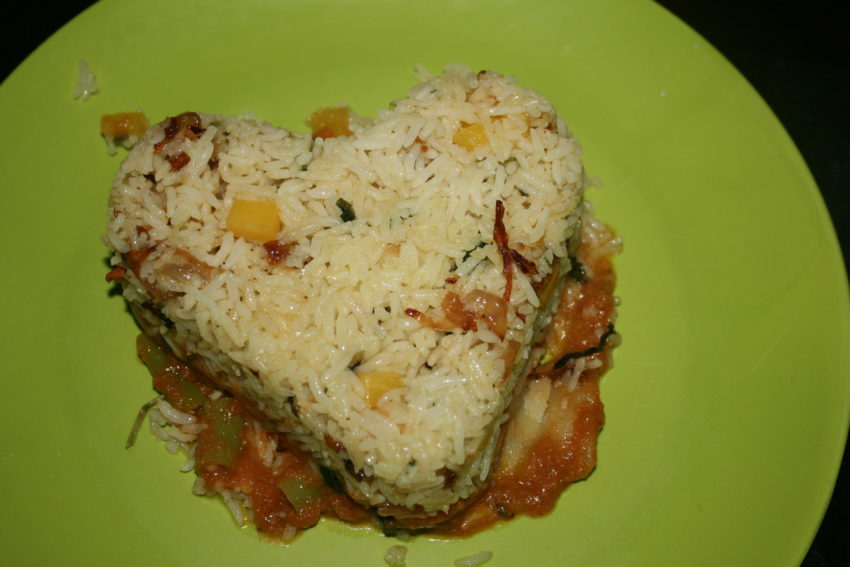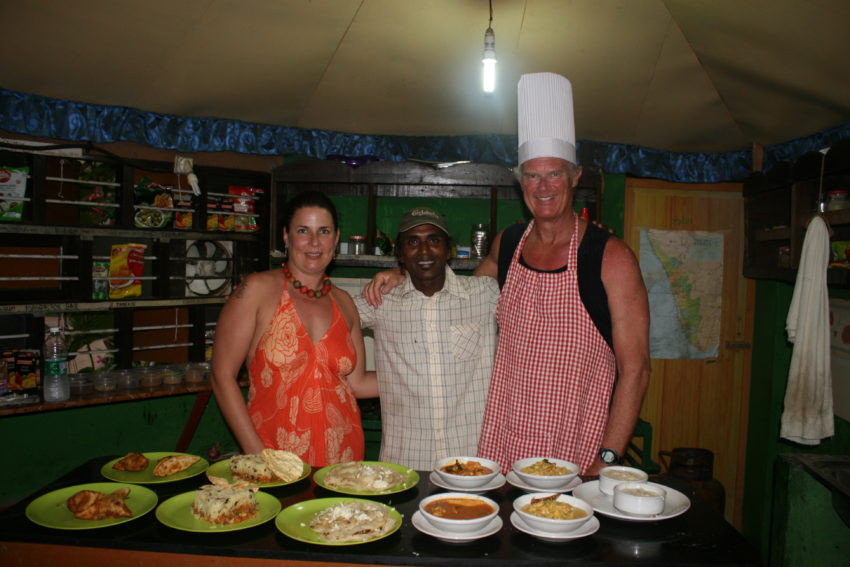There’s starving in India? Indian cooking class produces a feast fit for a village

VARKALA, India — The long menu looked intimidating to eat, let alone cook. Yet here I was staring at a menu that could feed an ashram. Forget the fact that I couldn’t pronounce half the dishes. How in the world was I going to prepare and cook a six-course Indian meal in two hours? It takes me that long to make pasta carbonara.
I’ve taken cooking classes in Malaysia and Italy but the class put on here by my Kerala Bamboo House is a truly gluttonous affair. Ever since I filled out the menu request the day before, I almost fasted. Hey, again, when in India …
Seriously, the menu I filled out included: starter, Indian bread, vegetarian dish, non-vegetarian dish, rice dish, dessert. The guesthouse has a recipe book the size of a Denny’s menu. Many of the dishes’ names sounded like something you’d chant during meditation.

But I fearlessly dove in due to one inescapable fact: Indian food is fabulous.
People come to India for different reasons but spirituality is No. 1. People come here for that horrible cliche: finding themselves. Yoga. Meditation. Massage. Everyone is trying to find another level of consciousness, happiness and fulfillment.
The main reason I came to India was to fill my belly.
There is nothing more hearty than dipping a big fat piece of naan bread into thick, orange masala gravy. I love the smell of tandoori chicken when it’s sizzling on your plate. Balsamic rice is the loner of the rice family. It’s good enough to stand alone. I’ve had fabulous meals every day in this cliffside village. From tandoori marlin to chicken masala to puri bhaji, a terrific breakfast dish of potatoes and peas in a brown gravy spiced with ginger, garlic and onion. Every meal is a sensual experience. That’s good. It’s the only sensual experience I’ll have in India.
But what I was undertaking was going to make my previous meals look like snacks at 7-Eleven.

Joining me was Melanie Seal, a 40ish India junkie from the isle of Jersey between England and France. She has done the whole India ashram experience. She also works in the exporting-importing business so comes to India for gems and textiles. This was her fourth cooking class at Bamboo House.
We were met on the sandy walkway outside the kitchen by the chef. He calls himself Ani Cook, the kind of handle you acquire when you work at the same kitchen for 21 years. Standing about 5-7, Ani is a wiry, clean-shaven man with burning dark eyes. He wore a long-sleeve dress shirt (How do Indians wear anything but tank tops in this heat?) under a beat-up Carlsberg beer ball cap.
The Bamboo House kitchen is decent size but seems as old as the 100-foot cliff on which the guesthouse rests. The concrete counters are painted a green color that long ago started to fade. The stove is black iron. The kitchen won’t land in Sunset magazine but it had plenty of room for Ani to dart around showing us how to prepare a meal that could feed half of South India.

You can always tell an Indian kitchen. In one corner is a rainbow of spices spanning the color chart and India’s entire geographical expanse. The orange corianders, the red chili powder, the yellow mustard seed. Indian spice markets are more photographed than Indira Gandhi just for their colors alone. The flavors, however, make Indian food explode.
But holy hell, the list of ingredients for a basic Indian diet staple is as long as the Mumbai phonebook.
We started with the preparation. Melanie and I chopped onions and garlic and ginger into tiny bits and placed them onto little individual plates. We took turns cooking and writing down the recipes. Our first dish was the samosa. If you’ve had appetizers at Indian restaurants, you’ve at least seen them. They’re golden-fried triangles of crispy dough filled with spices and herbs and vegetable bits.
While I held the cast iron wok by a detachable metal handle, Ani announced all the ingredients he was throwing in the pot.
“Six teaspoons coconut oil,” he said. “Two teaspoons ginger. Six teaspoons onions. Two teaspoons garlic …”

In all (a recipe will follow below), samosas took 14 ingredients and that’s even before we started the, um, heavy lifting.
Soon the kitchen filled with the aromas of India. I’m not talking sweat and sewage. I’m talking cumin and coriander and turmeric and curry. The end result was a deep hunger setting up camp in my stomach. The beauty of cooking is you smell everything you cook before you eat. By the time you sit down, the hunger pangs have turned into monsters. They must be released.
Cooking Indian food with so many spices filling the air is almost torturous. An overhead fan thankfully kept the kitchen cool as the late afternoon humidity socked in the village. The fan whipped around the spices’ aromas like delicious fairy dust.
The samosa pockets take some work. Ani poured 300 grams of wheat flour into a bowl, threw in a teaspoon of salt and added 400 milligrams of water. In very broken English, he told me to mix up the ingredients. I said, in perfect English, “Where’s the spoon?” He laughed.
“You use your hands,” Melanie said. “Indian style.”
So as music from Kerala’s Malayalam language filled the air, I dug into the big mess and turned it all into a bigger mess. I had more dough on my hands than on the black countertop. Ani, working with the hand quickness of a Benihana chef, turned his mixture into six quick balls of dough. When I finally got my flour into a couple of neat rolls, we flattened them out, rolled them with a rolling pin and cut out perfect round dough shells from small dinner plates.
Ani then mixed a small amount of wheat flour and water to make a thin paste, kind of like vanilla frosting. We cut the pastry in half and folded one corner up to the halfway point to the curved bottom. We took the other half and folded to the opposite corner to form a pocket. Ani’s pockets were nice and deep and wide. Mine were wimpy and shallow and saggy, kind of like some of my dates in Las Vegas. But that’s another story …
After a stifled laugh, Ani did a little minor surgery and we started stuffing the pockets with the samosa mixture. Using the paste as a light glue, we folded the pockets into nice big, fat triangles.

We set them aside and made one of the sweetest sounding dishes I’ve ever heard. Pineapple tomato yogurt curry. Doesn’t that sound like the perfect wake-up call? Sweet, sour and fresh while overlooking a perfect beach and clear blue ocean?
This is a Kerala specialty where pineapples grow wild in the forests not more than a kilometer from the Indian Ocean. Fruit is huge in South India. Meat is huge in North India. But all the regional cuisines of India’s 29 states intermingle with each region adding their own twist. In Kerala, long-grain white rice, about twice as long as what we buy in the U.S., is huge. Kerala’s green cardamom is considered the world’s best. When Christopher Columbus, stumbled onto America, he was actually looking for the black pepper that peppered Kerala’s coast.
Pineapple tomato yogurt curry is real easy to make. It just takes a lot of time — and a real good Indian grocery store. The ingredients are — deep inhale — 4 teaspoons coconut oil, 1 teaspoon mustard seed, one teaspoon fenugreek leaves, four teaspoons ginger, four teaspoons garlic, four stems curry leaf, four dry chilies, four tablespoons chopped onion, 1 ½ teaspoons salt, 200 grams chopped pineapple, a pinch of chili powder, a pinch of cumin powder, 400 milligrams of water, two tomatoes cut into eight wedges, six tablespoons chopped coconut, 200 milligrams plain yoghurt and — finally — a pinch of coriander.
Mix the coconut and yogurt separately and combine with the other ingredients in big, sloppy, lumpy, yellow delicious pile of goodness.
A few dishes later, the three of us gathered behind a table with 12 dishes. Ani managed to pour the vegetable biryani rice dishes into the shapes of hearts right on the plate. That was a nice touch even though South India’s humidity has crushed my libido into fine powder, similar to what I sprinkled on my food without nearly the kick.
Melanie and I took our haul to a picnic table outside. The bowls of food covered every inch of space on the table. When I tell people about cooking, I say I’m a good cook. But in Rome, I’m a really good cook. In India, I am, too.
The food was absolutely fabulous. The samosas were crispy and the vegetable mixture was a warm kaleidoscope of spices that mixed perfectly. I dipped the cheese paratha (shredded Indian bread) into the yogurt sauce for a nice sweet and sour jam. The chicken masala was a big thick soup packed with chunks of fat, juicy chicken. The meal was topped by a bowl of coconut payasam, a light, warm coconut pudding.
It was all too much. I told Melanie, “I can’t believe there are people actually starving in this country.”
It was so much, we nearly hogtied and dragged a passing couple to join us. It didn’t take much convincing. Hugo, a Brit, and his Japanese wife took one look at our spread and slowed down their pace. Then they smiled. We asked them to join us and we didn’t have to ask twice. They blew off dinner plans and dug in.
The whole event cost Melanie and I 750 rupees each. That’s about $12.50 for a meal that would cost $30 at any average Indian restaurant in the U.S. or the U.K. But it wasn’t the tastes that sold me. It was the ingredients. It was the smells. It was the tradition of a culinary culture that goes back 4,000 years. Some of the ingredients we used have been put into food since the Indus Valley first began a civilization in 2,600 B.C.
There are so many Indias. There are so many Indian foods. Kerala is just one slice of it, a sliver on the huge banyan tree that is Indian cuisine.
SAMOSA INGREDIENTS
6 teaspoons coconut oil
2 teaspoons ginger
6 teaspoons onion
2 teaspoons garlic
3 stems curry leaves
1 1/2 teaspoons salt
1 teaspoon turmeric
2 teaspoons coriander powder
2 teaspoons masala
1 teaspoon chili powder
1 teaspoon cumin powder
200 grams mixed vegetables: carrots, beans, potato, cauliflower
1 teaspoon coriander


April 23, 2015 @ 3:38 pm
We will definitely take at least one class while there; but it sounds like maybe a couple since the cooking is so regional and we will go north to south. Is Sri Lanka cooking pretty much the same? You mentioned balsamic rice as well as biryani rice. Are they similar?
April 23, 2015 @ 11:04 pm
Biryani is the name of the dish; basmati is the name of a long-grained rice used in South India. Sorry for the confusion.